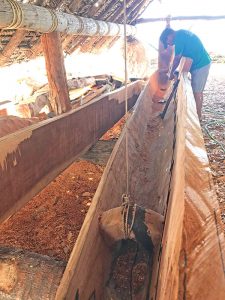Time running out for canoe

Grand master navigator Antonio “Tony” Piailug buffs the base of the canoe at the canoe house in Susupe last Jan. 15. (JUSTINE NAUTA)
There’s good news and bad news about the traditional canoe that is intended to be shown at the Festival of the Pacific Arts in Hawaii this June.
The good news is that the canoe’s base—which is usually used to hold supplies—is halfway done.
The bad news is that time is running out on the canoe, with only a little over five months left for it to be done in time for the FestPac. The two men who are currently working on the canoe at the canoe house in Susupe—grand master navigator Antonio “Tony” Urmeyang Piailug and John Castro, project coordinator of the seafaring tradition program of the Department of Community and Cultural Affairs—are hopeful but they themselves have doubts, that the remaining five months may not be enough time for them to finish making the canoe in time. The two have been working on making the canoe since October 2018 in Susupe.
When finished, the canoe would be approximately 34 feet long. Right now, the base is the only thing that is almost finished. Piailug and Castro have their work cut out for them since they are the only two working on the canoe and if they want to meet the deadline of testing the canoe to see if it’s ready to sail. As for when it will be done, that is still a big question mark.
The traditional canoe will be made out of dokduk—breadfruit tree—that was harvested from Rota and the sail will be made out of a nylon canvas fabric.
Plans to sail the canoe from here to Hawaii is “impossible,” since the storage space of the canoe will only be able to hold a week’s worth of food supplies and that won’t be enough for a trip that is estimated to take three months of sailing. If the idea is to sail to Hawaii to make it to the FestPac, they should have started sailing yesterday, according to both Piailug and Castro. Shipping the canoe to Hawaii to showcase it at FestPac 2020 seems more doable.
The traditional canoe has been in the works since 2017 and should have been almost finished but, due to multiple storms, parts that were needed weren’t available after Super Typhoon Yutu hit in October 2019.
“It would be the most honorable thing to have a maiden voyage to the island of Rota to present to the animås [ancestral spirits] what we made out of what we took from them,” said Castro.
“We’re connected by the water, the important thing is to show the people that this [sailing] is what our ancestors used to do when they needed to go [from] island to island,” said Piailug.























